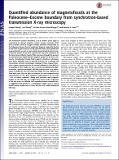Quantified abundance of magnetofossils at the Paleocene–Eocene boundary from synchrotron-based transmission X-ray microscopy
Author(s)
Wang, Huapei; Wang, Jun; Chen-Wiegart, Yu-chen Karen; Kent, Dennis V.
DownloadWang-2015-Quantified abundance.pdf (2.519Mb)
PUBLISHER_POLICY
Publisher Policy
Article is made available in accordance with the publisher's policy and may be subject to US copyright law. Please refer to the publisher's site for terms of use.
Terms of use
Metadata
Show full item recordAbstract
The Paleocene–Eocene boundary (∼55.8 million years ago) is marked by an abrupt negative carbon isotope excursion (CIE) that coincides with an oxygen isotope decrease interpreted as the Paleocene–Eocene thermal maximum. Biogenic magnetite (Fe[subscript 3]O[subscript 4]) in the form of giant (micron-sized) spearhead-like and spindle-like magnetofossils, as well as nano-sized magnetotactic bacteria magnetosome chains, have been reported in clay-rich sediments in the New Jersey Atlantic Coastal Plain and were thought to account for the distinctive single-domain magnetic properties of these sediments. Uncalibrated strong field magnet extraction techniques have been typically used to provide material for scanning and transmission electron microscopic imaging of these magnetic particles, whose concentration in the natural sediment is thus difficult to quantify. In this study, we use a recently developed ultrahigh-resolution, synchrotron-based, full-field transmission X-ray microscope to study the iron-rich minerals within the clay sediment in their bulk state. We are able to estimate the total magnetization concentration of the giant biogenic magnetofossils to be only ∼10% of whole sediment. Along with previous rock magnetic studies on the CIE clay, we suggest that most of the magnetite in the clay occurs as isolated, near-equidimensional nanoparticles, a suggestion that points to a nonbiogenic origin, such as comet impact plume condensates in what may be very rapidly deposited CIE clays.
Date issued
2015-10Department
Massachusetts Institute of Technology. Department of Earth, Atmospheric, and Planetary SciencesJournal
Proceedings of the National Academy of Sciences
Publisher
National Academy of Sciences (U.S.)
Citation
Wang, Huapei, Jun Wang, Yu-chen Karen Chen-Wiegart, and Dennis V. Kent. “Quantified Abundance of Magnetofossils at the Paleocene–Eocene Boundary from Synchrotron-Based Transmission X-Ray Microscopy.” Proc Natl Acad Sci USA 112, no. 41 (September 29, 2015): 12598–12603.
Version: Final published version
ISSN
0027-8424
1091-6490